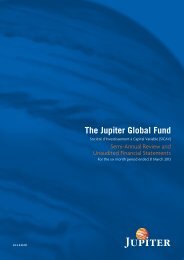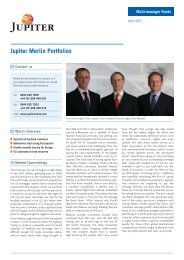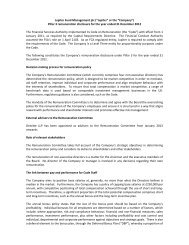The Jupiter Global Fund - Jupiter Asset Management
The Jupiter Global Fund - Jupiter Asset Management
The Jupiter Global Fund - Jupiter Asset Management
Create successful ePaper yourself
Turn your PDF publications into a flip-book with our unique Google optimized e-Paper software.
the jupiter global fund<br />
<strong>Jupiter</strong> <strong>Global</strong> Equities<br />
■■<strong>Jupiter</strong> <strong>Global</strong> Equities Review of Portfolio as at 30 September 2012<br />
Performance<br />
NAV 30.09.12 30.09.11 % Change<br />
Class L US Dollar Shares USD 12.30 USD 10.26 19.88%<br />
Class L Euro Shares EUR 13.97 EUR 11.16 25.18%<br />
Class L Sterling Shares GBP 11.24 GBP 9.83 14.34%<br />
Market Review<br />
Concerns over global growth and the absence of a satisfactory<br />
resolution to the eurozone crisis have been the main influences on<br />
markets in the period under review. Towards the end of 2011, markets<br />
fell as investor confidence waned, but sentiment was restored by the<br />
introduction of a lending programme for European banks called the<br />
Long Term Refinancing Operation in early 2012. <strong>Global</strong> equities<br />
rallied, supported also by better economic data from the US. However,<br />
by the second quarter, evidence had begun to emerge that growth in<br />
developing economies such as China and India was slowing and<br />
interest rates in those countries were cut by way of response.<br />
Performance in global markets fell back and, at the same time,<br />
concerns over the solvency of Spain’s financial sector mounted. This<br />
nervousness was compounded after the Dutch government collapsed<br />
over failure to agree austerity measures and socialist leader François<br />
Hollande became President of France. <strong>The</strong> head of the European<br />
Central Bank (ECB), Mario Draghi, announced in a pivotal speech in<br />
July that he would do ‘whatever it takes’ to ensure the survival of the<br />
eurozone, commitment that shored up global markets through the<br />
summer months. In early September, a bond-buying operation called<br />
‘Outright Monetary Transactions’ was launched by the ECB in an<br />
attempt to bring down worryingly high yields on southern European<br />
sovereign debt. With key economic data remaining gloomy, the US<br />
Federal Reserve nonetheless felt obliged to introduce a third round of<br />
quantitative easing in September, and the ensuing rush of liquidity<br />
boosted markets at the end of the period under review.<br />
Policy Review<br />
For the year to 30 September 2012, the <strong>Fund</strong> returned 19.9%, compared<br />
to 22.3% for its benchmark, the MSCI World index in US dollar terms.<br />
Our underweight position in financials weighed on performance in the<br />
period under review. <strong>The</strong> <strong>Fund</strong> has a heavily overweight bias towards<br />
consumer goods and services – almost double that of the index – and<br />
this has served us well in terms of performance. Sector-wise, basic<br />
materials and technology also made good returns. Consumer staple<br />
companies with international reach such as Wal-Mart and Philip Morris,<br />
both of which are core holdings for the <strong>Fund</strong>, made strong returns while<br />
Australia’s Newmont Mining detracted, suffering from the drop in global<br />
commodity prices. <strong>The</strong> <strong>Fund</strong>’s overweight position in two northern<br />
European economies – Germany and the Netherlands – supported<br />
performance and has been ramped up from just over 6% to just over<br />
11% in the period under review.<br />
Investment Outlook<br />
Signs of stability have emerged in the US property market and the<br />
eurozone countries have made some progress in tackling the debt<br />
crisis, but much work still needs to be done. We have selective<br />
exposure to both these regions, as we believe it is possible to pick up<br />
high quality companies at reasonable valuations, especially within the<br />
large-cap sector. We continue to see the best value in emerging<br />
market equities but the Federal Reserve’s third round of quantitative<br />
easing is likely to precipitate a rush of liquidity into traditionally higheryielding<br />
emerging market assets, and this could push inflation in those<br />
areas to uncomfortably high levels. In the meantime, however,<br />
fluctuations in emerging markets resulting from news flow concerning<br />
western economies are presenting patient long-term investors with<br />
what are, in our view, attractive entry points.<br />
We remain optimistic that although economic growth is tapering, the<br />
Chinese economy will nonetheless avoid a hard landing. We are also<br />
confident that once the transition of political power has taken place by<br />
the end of the year, new measures will be introduced to stimulate<br />
growth and manage the country’s transition from a trade and exportoriented<br />
economy to a consumption-led economy. Following a visit to<br />
the Philippines and Indonesia in the summer, we are also upbeat<br />
regarding the growth prospects for the smaller countries in Asia. We<br />
were impressed by the state of government and corporate finances,<br />
as well as the extent to which these economies’ growth is driven<br />
domestically rather than through export dependency. Overall, we have<br />
slowly been increasing the portfolio’s exposure to emerging market<br />
equities through the course of the period under review.<br />
Ben Surtees<br />
30 October 2012<br />
68








